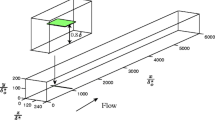Abstract
A novel approach was proposed to developing a combined algebraic-differential model of turbulent viscosity, which was then used to modify the traditional method for calculating turbulent boundary layers on bodies of revolution immersed in an incompressible flow. Ample experimental data were invoked to test the developed model through prediction of features inherent in turbulent boundary layers on the body of revolution in the presence of Large Eddy BreakUp (LEBU) devices installed in the vicinity of the streamlined surface. Within the developed approach, we showed it possible to calculate the evolution of local governing characteristics of turbulent flow in a broad range of LEBU parameters.
Similar content being viewed by others
References
V. Shmitt, Réduction de la traînée de l’avion de transport subsonique, tendances et perspectives actuelles, L’Aéronautique et l’Astronautique, 1988, Vol. 2, No. 129, P. 4–18.
V.T. Truong, Drag Reduction Technologies, Aeronautical and Maritime Research Lab. Report DSTO-GD-0290, Australia, June 2001.
V.I. Kornilov, Reduction of turbulent friction by active and passive methods (review), Thermophysics and Aeromechanics, 2005, Vol. 12, No. 2, P. 183–208.
2nd Int. Symp. on Seawater Drag Reduction, Busan, Korea, 23–26 May 2005 (CD).
Int. Conf. on Superfast Marine Vehicles Moving above, under and in Water Surface, St. Petersburg, Russia, 2–4 July 2008 (CD).
J.N. Hefner, Problem of drag reduction. Saving on propellant cost, Aerospace America, 1988, No. 1, P. 14–16.
V.G. Gorshkov and V.I. Kornilov, Effect of Large Eddy Breakup Devices on the Characteristics of the Turbulent Boundary Layer on the Body of Revolution, Preprint No. 4-2003, Inst. of Theoretical and Applied Mechanics SB RAS, Novosibirsk, 2003.
V.I. Kornilov, Skin-friction reduction on body of revolution using boundary-layer alteration devices, AIAA J., 2005, Vol. 43, No. 10, P. 2125–2132.
I.A. Belov, V.A. Shelenshkevich, and L.I. Shub, Modelling of Hydromechanical Processes in Semiconductor and IC Technology, Politekhnika, Leningrad, 1991.
F.R. Menter, Eddy Viscosity Transport Equations and Their Relation to the k−ε Model, NASA Technical Memorandum 108854, November, 1994.
V.T. Movchan and E.A. Shkvar, Modelling of Turbulent Near-Wall Shear Flows Properties, High Speed Body Motion in Water, AGARD Report 827, 1997, P. 10-1–10-7.
V.T. Movchan, Mathematical models of turbulent viscosity in calculations of wall flows, in: Aerohydrodynamics: Problems and Prospects for Future, Collection of Scientific Papers, National Aerospace University KhAI, Ukraine, 2006, P. 272–286.
E.A. Shkvar and V.I. Mamchuk, Mathematical modelling of turbulent wall jet flows, in: Current Problems in Sea Supremacy, UDAVG, Rovno, 1997, Vol. 1, P. 124–127.
K.K. Fedyaevsky, A.S. Ganevsky, and A.V. Kolesnikov, Calculation of Turbulent Boundary Layer in Incompressible Liquid, Sudostroenie, Leningrad, 1973.
S. Mochizuki, S. Yamada, and H. Osaka, Management of a plane wall jet by large eddy break-up device, JSME Int. J., Ser. B, 2006, Vol. 49, No. 4, P. 921–927.
Author information
Authors and Affiliations
Corresponding author
Rights and permissions
About this article
Cite this article
Kornilov, V.I., Shkvar, E.A. Modelling of turbulent boundary layers on the body of revolution in the presence of large eddy breakup devices. Thermophys. Aeromech. 17, 309–321 (2010). https://doi.org/10.1134/S0869864310030029
Received:
Published:
Issue Date:
DOI: https://doi.org/10.1134/S0869864310030029




